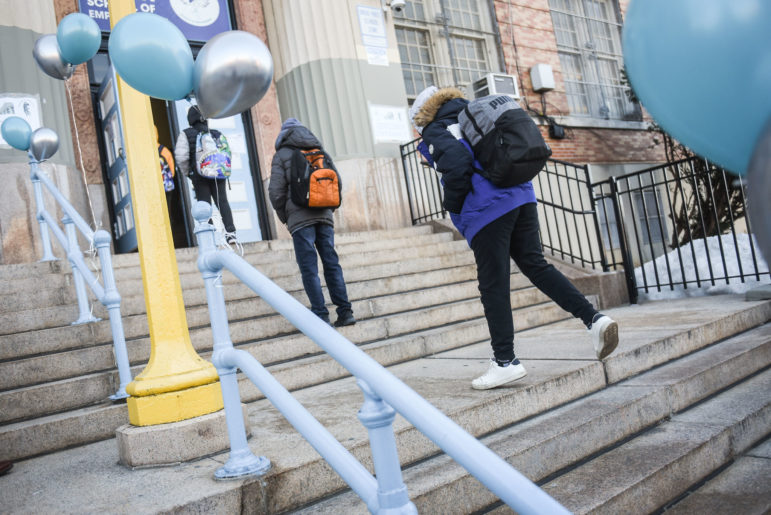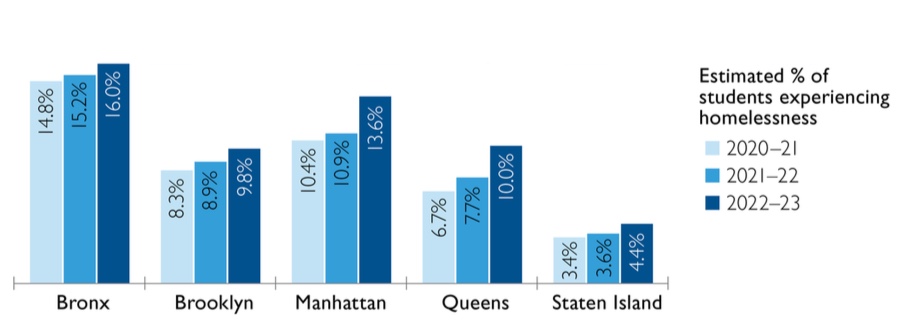A record-high of 119,320 students during the 2022-2023 school year were living in the shelter system, “doubled up” in the housing of others or staying in hotels, motels or unsheltered, a new analysis found. The numbers mark the eighth consecutive year that the city’s population of homeless students surpassed 100,000.

Michael Appleton/Mayoral Photography Office
Students head into school in New York City in February 2021.A record-high of 119,320 New York City public school students experienced homelessness last school year, a new analysis found—marking the eighth consecutive year that the city’s population of homeless students surpassed 100,000.
The latest numbers, released by the nonprofit Advocates for Children (AFC) based on data from the state’s education department for the 2022-2023 school year, are 14 percent higher than the year before, and higher than a previous record of 115,000 homeless students in 2017-2018.

Advocates for Children
The number of “temporarily housed” students in the city’s public schools by year.“While the recent increase in the number of immigrant families arriving in New York City has brought greater public attention to the issue, student homelessness is not a new phenomenon,” the report notes.
RELATED READING: Comptroller Calls for School Funding Changes to Accommodate Asylum Seeker Enrollments
The majority of students who experienced homelessness last year, 61 percent, were kids living “doubled up” in shared housing. Another 34 percent spent time in the shelter system, and 5,900 kids were living in hotels, motels, were unsheltered or “otherwise lacking a regular and adequate nighttime residence,” the report says.
Students experiencing homelessness and housing insecurity “face tremendous obstacles in school,” the report notes, including higher high school drop out rates and chronic absenteeism, according to AFC.
“No child in New York City should be homeless, but until we reach that goal, access to a quality education is our best possible tool for ensuring those living in shelter don’t re-enter the system as adults,” Kim Sweet, the group’s executive director, said in a statement.
While all five boroughs saw an uptick in student homelessness last year, rates were highest in the Bronx, where 1 in every 6 schoolchildren were temporarily housed. Three school districts had the highest rates in the city, where more than 20 percent of the school population experienced homelessness: Bronx District 9, which spans Morris Heights and Mount Eden, and Brooklyn Districts 32 in and 23 in Bushwick and Brownsville, respectively.

Advocates for Children
The number of “temporarily housed” students in the city’s public schools by year and by borough.To address the many academic obstacles unhoused children face, the report calls for NYC Public Schools (NYCPS) to expand its number of shelter-based support staff, who can help families connect with additional services as well as aid newly-arrive immigrant families with enrollment.
While the city hired 100 shelter-based “Community Coordinators” last year to do this type of work, the positions were created with temporary funding, and more than 100 new emergency shelters have opened in the time since which lack that support staff, AFC says.
“The City should be increasing shelter-based public school staff to meet the tremendous need—and at the very least needs a plan to sustain these critical positions,” Sweet said in statement.
AFC and other advocates have also condemned the city’s latest policy of issuing deadlines to some newly-arrived immigrant families with children in the shelter system, which officials say is out of space, making them re-apply for new placement every 28 or 60 days.
While Mayor Eric Adams has pledged that “every child will remain in their school” despite the frequent moves, advocates are skeptical.
“While students who move to a new shelter placement have the right to stay in their original school, we know from our experience working with families that this is often a right in name only,” Jennifer Pringle, director of AFC’s Learners in Temporary Housing project, said in a statement. “Parents often feel they have no choice but to uproot their children from schools they love when they move shelters.”
You can read the report in full below.








